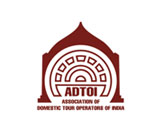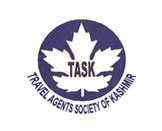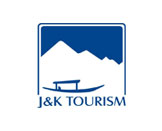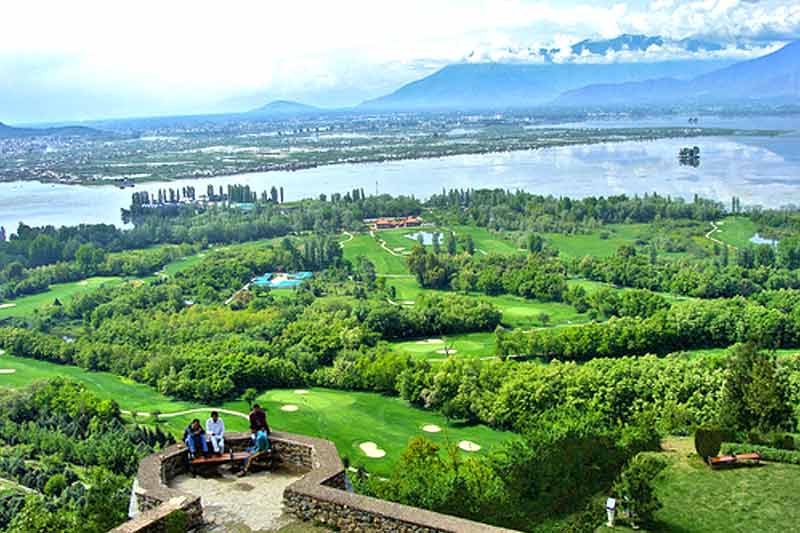
The city of Srinagar is a gateway to some of the most scenic and beautiful places of the Indian subcontinent. The hill station and skiing resort Gulmarg is 50 km from the city. For decades, tourism has been contributing massively to the economy of the city, but it has been adversely affected on account of insurgent activities by certain elements.The areas on the outskirts of Srinagar are also famous for their natural beauty.
Srinagar is well known for its lakes. Dal Lake is known for its houseboats. Nagin Lake is another famous lake in the city.
Just outside the city are found the Shalimar Gardens created by Jehangir, the Mughal emperor, in 1619.
Srinagar has several gardens which are part of the several such gardens laid by the Mughal emperors across the Indian subcontinent, and which are known as Mughal gardens. The Mughal Gardens located in Srinagar and its close vicinity includes Chasma Shahi (the royal fountains); Pari Mahal (the palace of the fairies); Nishat Bagh (the garden of spring); Shalimar Bagh; and the Nashim Bagh. The Tulip Gardens have been recently opened to public by Smt Sonia Gandhi. The gardens have rows of Tulips of different colurs and shades.
It has been called the "Venice of the East" or the "Kashmiri Venice".
Places to visit:
Dal Lake, Nishant Bagh, Chashme Sahi, Shankracharya Temple, Jamia Mosque, Shalimar Bagh
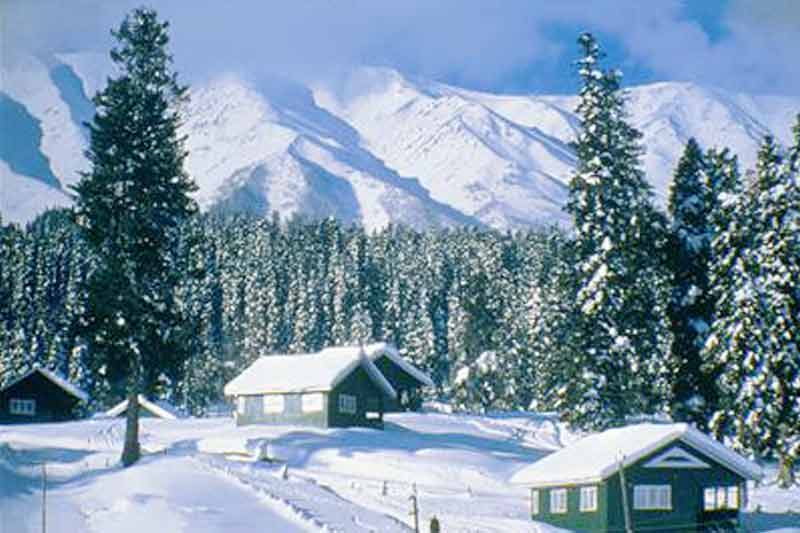
Gulmarg has been a resort for the kings like Yousuf Shah Chak and Jahangir who used to visit frequently. The old name of Gulmarg was "Gaurimarg", the name of Lord Shiva's wife. Yousuf Shah Chak changed its name to Gulmarg, meaning the place of roses. During the early part of the 20th century the famous Central Asian explorer Sir Marc Aurel Stein (1862 – 1943), made his home here in a tent between his expeditions. It was a favourite summer holiday destination for the British stationed in India.
Gulmarg has quickly become one of the state's most visited destinations. The slopes of the Afarwat Hills of the Pir Panjal Range of the Himalaya Chain boast one of the longest and highest ski slopes in Asia.
Gulmarg boasts Asia's highest and longest cable car project, the Gulmarg Gondola. The two-stage ropeway ferries about 600 people per hour to and from Kongdoori Mountain, a shoulder of nearby Afarwat Peak (4,200 m (13,780 ft)). The ropeway project is a joint venture of the Jammu and Kashmir government and French firm Pomagalski. The first stage transfers from the Gulmarg resort at 2,600 m (8,530 ft) to Kongdoori Station in the bowl-shaped Kongdori valley. The second stage of the ropeway, which has 36 cabins and 18 towers, takes skiers to a height of 3,950 m (12,959 ft) on Kongdoori Mountain, a shoulder of nearby Afarwat Peak (4,200 m (13,780 ft)). The second stage was completed in a record time of about two years at a cost of Rs 11 crore and opened on May 28, 2005. The French company had also built the first phase of the gondola project, connecting Gulmarg to Kongdoori, in 1998.
Skiing is normally offered from mid-December to mid-May. The JKSCCC also proposes to construct chair lifts which will connect Kongdoori with Merry Shoulder peak for beginners and intermediate skiers. Gulmarg is being mooted as a possible host for the 2010 Commonwealth Winter Games. There are a few places of religious importance near the resort within a 5 to 20 km radius like Baba Reshi, Haji Murad at Kreeri etc.
Places to visit:
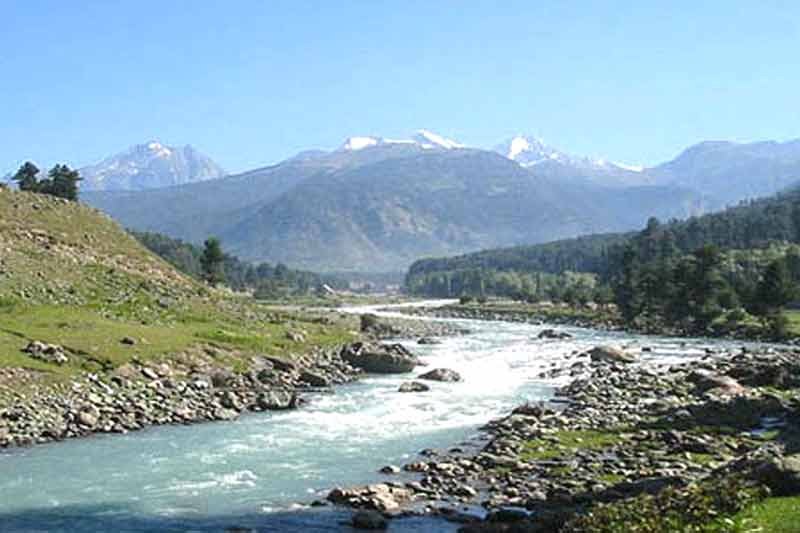
Arguably one of the most beautiful places on earth, the town of Pahalgam (Village of Shepherds) offers breathtaking views. One can just relax in one of the many hotels in Pahalgam, or trek on some of the many mountains. One can trek to Lidderwat, Kolohoi Glacier or to Sonmarg. Snow skiing is an attraction during the winter months (from December to late February).
Pahalgam is also the entry point for the famous Amarnath Cave, a holy site for Hindus.
Kolohoi Glacier, situated up the Lidder Valley, just below Mount Kolohoi, is currently a hanging glacier. It is basically hollowed out from global warming, the Asian brown cloud, and local environmental factors associated with mountain hydrology. According to the mountaineers from Jawahar Institute of Mountaineering (JIM)in 2008, the glacier has receded by half since 1985. The glacier is not safe to study because it is hollow and in places has 200 foot deep crevasses. The sounds of cracking can be heard from either side of the ice field, which indicates an imminent collapse. The preferred method of approach for viewing is to take the right side. This approach offers less boulder fields on the approach, and the occasional goat/horse/cattle herder can be approached for cheese and Kashmiri tea on the way. Reaching Kolohoi, trekking up the Lidder Valley, you will encounter some of the most difficult terrain in the western Himalaya, but the views are breathtaking.
Places to visit:
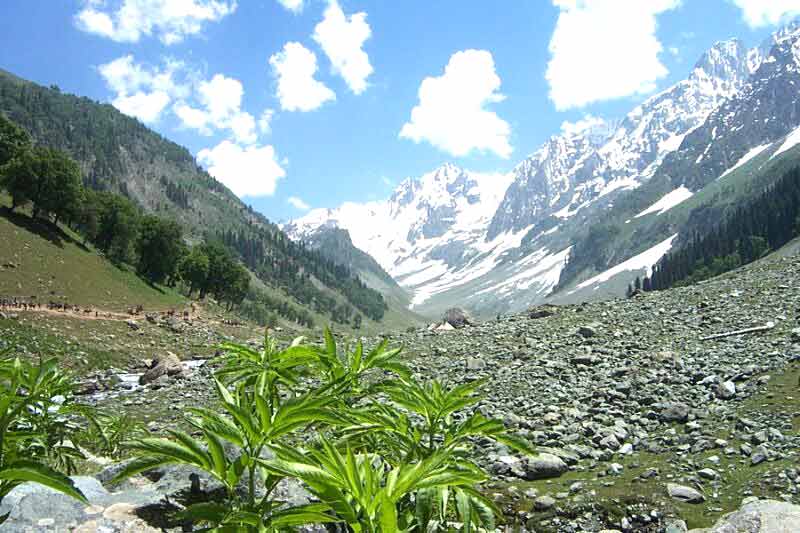
Sonamarg, which means ' meadow of gold ' has, as its backdrop, snowy mountains against a cerulean sky. the Sindh meanders along here and abounds with trout and mahseer, snow trout can be caught in the main river.Ponies can be hired for the trip up to Thajiwas glacier a major attraction during the summer months.
The climate of Sonamarg is very bracing; but the rainfall is frequent though not heavy, except for two or three days at a time in July and August with fine spell in between. From Sonamarg, trekking routes lead to the Himalayan lakes of Vishansar (4084 msl), Krishnasar (3810 msl) and Gangabal (3658 msl). Other lakes in the region are Gadsar, stocked with snowtrout and Satsar, glacier-fed and surrounded by banks of alpine flowers.
Sonamarg, at an altitude of 3,000 metres above sea level, 87 km north-east of Srinagar. The drive to Sonamargh is though yet another spectacular facet of country side in Kashmir, this time in Sindh Valley. The Sindh Valley is the largest tributary of the valley of Kashmir. It is upwards of sixty miles long, and valley and deep rock-girt gorge to open grassy meadow land and village-dotted slopes.
A close by excursion is to Baltal, 15 km north of Sonamarg. This little valley lies at the foot of the Zojila, only a day's journey away from the sacred cave of Amarnath. Trekkers can also reach the starkly splendid roof-top of the world – Leh, by crossing over the Zoji La pass.
Places to visit:
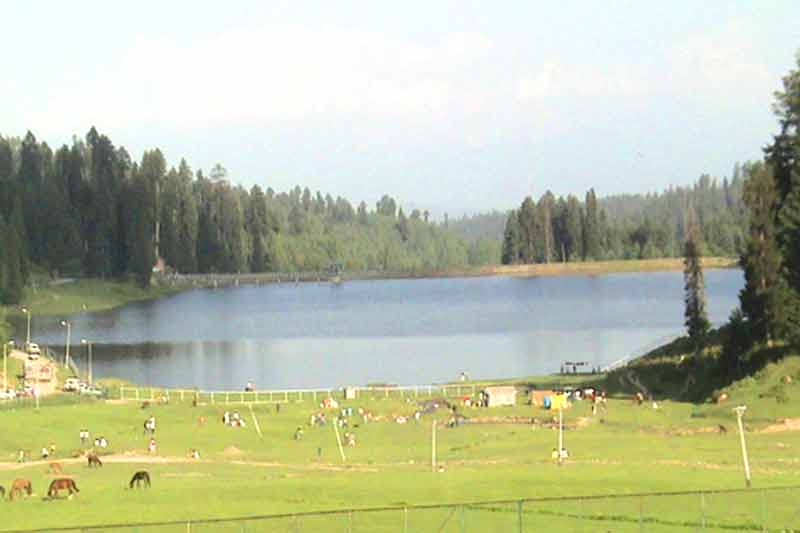
Yusmarg is a small meadow set in the heart of mountains to the south-west of Srinagar. It is an ideal picnic spot and the Nilnag Lake can be visited from here. A two hour drive from Srinagar ( 47 kms ) will take you to acres upon acres of grassy meadow ringed by forests of pine, and towering beyond them, awesome and majestic snow clad mountains.
Nearby are several peaks-Tatta Kutti and Sang Safed to name a couple of them. About 13 kms from Yusmarg, a short detour away from the Srinagar road, is Charari- Sharief, the Shrine of Kashmir’s patron saint Sheikh Noor-ud-din or Nund Reshi, now rebuilt after the devastating fire of 1994 which engulfed the entire building.
Among the popular places of tourist interest include Leh, Drass valley, Suru valley, Kargil, Zangskar, Zangla, Rangdum, Padum, Phukthal, Sani Monastery, Stongdey, Shayok Valley, Sankoo, Salt Valley. Popular treks are Manali to Ladakh, the Nubra valley, the Indus valley, Markha valley, Ladakh monastery trek, South Zangskar, Trans-Zangskar Expedition, Spiti to Ladakh, Spiti to Pitok to Hemis, Rupshu, the Great Salt lakes, Chadar Ice trek, Padum-Phuktal, Padam to Darcha, Panikhar to Heniskot, Padum to Manali , Lamayuru-Martselang, Lamayuru - Alchi, Kala Pattar trek, Pahalgam to Suru valley, Kinnaur-Spiti-Ladakh, Tsomoriri-Lake Trek, and Manali-Leh trek.
Yusmarg is an ideal day-picnic resort.

Region in the state of Jammu and Kashmir of Northern India sandwiched between the Karakoram mountain range to the north and the Himalayas to the south. The Indian portion of Ladakh is composed of the Leh and Kargil districts. The Leh district is the largest district of India, covering more than half the area of Jammu and Kashmir, of which it is the eastern part.
Adventure tourism in Ladakh started in the 19th century. By the turn of the 20th century, it was not uncommon for British officials to undertake the 14 stage trek from Srinagar to Leh as part of their annual leave. Agencies were set up in Srinagar and Shimla to specialise sport related activities — hunting, fishing and trekking. A large retinue of porters would carry huge canvas tents and collapsible string beds. This era is recorded in Arthur Neves The Tourist's Guide to Kashmir, Ladakh and Skardo, first published in 1911[1]. Today, about 18,000 tourists visit Ladakh every year. Bounded by two mighty mountain ranges, it is a popular place for adventure tourism. The well-preserved Tibetan-Buddhist culture makes it even more attractive.
Among the popular places of tourist interest include Leh, Drass valley, Suru valley, Kargil, Zangskar, Zangla, Rangdum, Padum, Phukthal, Sani Monastery, Stongdey, Shayok Valley, Sankoo, Salt Valley. Popular treks are Manali to Ladakh, the Nubra valley, the Indus valley, Markha valley, Ladakh monastery trek, South Zangskar, Trans-Zangskar Expedition, Spiti to Ladakh, Spiti to Pitok to Hemis, Rupshu, the Great Salt lakes, Chadar Ice trek, Padum-Phuktal, Padam to Darcha, Panikhar to Heniskot, Padum to Manali , Lamayuru-Martselang, Lamayuru - Alchi, Kala Pattar trek, Pahalgam to Suru valley, Kinnaur-Spiti-Ladakh, Tsomoriri-Lake Trek, and Manali-Leh trek.
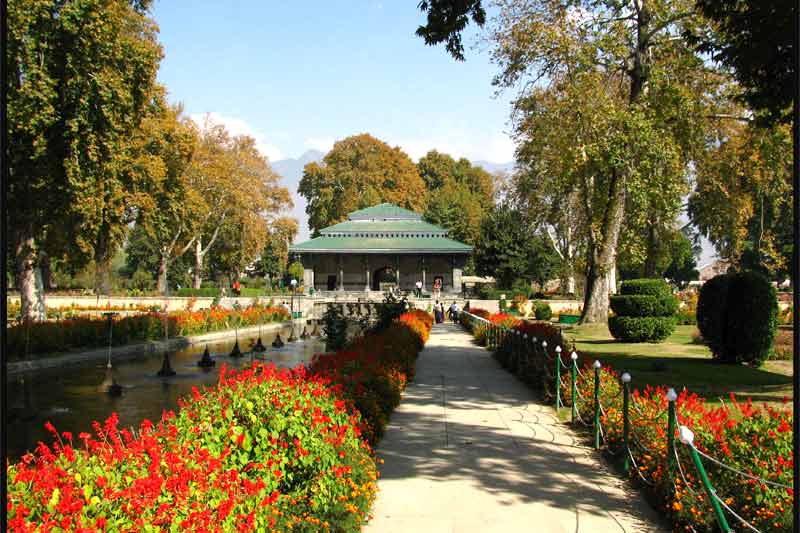
Region in the state of Jammu and Kashmir of Northern India sandwiched between the Karakoram mountain range to the north and the Himalayas to the south. The Indian portion of Ladakh is composed of the Leh and Kargil districts. The Leh district is the largest district of India, covering more than half the area of Jammu and Kashmir, of which it is the eastern part.
Adventure tourism in Ladakh started in the 19th century. By the turn of the 20th century, it was not uncommon for British officials to undertake the 14 stage trek from Srinagar to Leh as part of their annual leave. Agencies were set up in Srinagar and Shimla to specialise sport related activities — hunting, fishing and trekking. A large retinue of porters would carry huge canvas tents and collapsible string beds. This era is recorded in Arthur Neves The Tourist's Guide to Kashmir, Ladakh and Skardo, first published in 1911[1]. Today, about 18,000 tourists visit Ladakh every year. Bounded by two mighty mountain ranges, it is a popular place for adventure tourism. The well-preserved Tibetan-Buddhist culture makes it even more attractive.
Among the popular places of tourist interest include Leh, Drass valley, Suru valley, Kargil, Zangskar, Zangla, Rangdum, Padum, Phukthal, Sani Monastery, Stongdey, Shayok Valley, Sankoo, Salt Valley. Popular treks are Manali to Ladakh, the Nubra valley, the Indus valley, Markha valley, Ladakh monastery trek, South Zangskar, Trans-Zangskar Expedition, Spiti to Ladakh, Spiti to Pitok to Hemis, Rupshu, the Great Salt lakes, Chadar Ice trek, Padum-Phuktal, Padam to Darcha, Panikhar to Heniskot, Padum to Manali , Lamayuru-Martselang, Lamayuru - Alchi, Kala Pattar trek, Pahalgam to Suru valley, Kinnaur-Spiti-Ladakh, Tsomoriri-Lake Trek, and Manali-Leh trek.
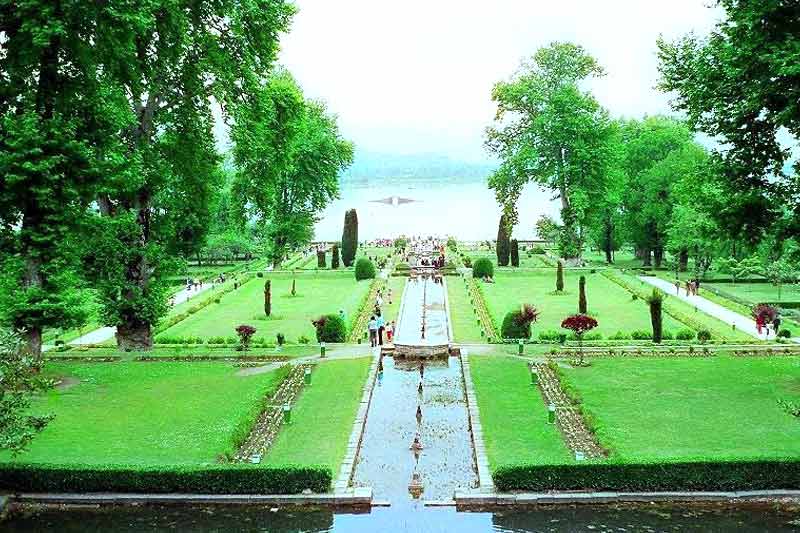
This garden is built on the eastern side of the Dal Lake, close to the Srinagar city in the state of Jammu and Kashmir in India. It is the second largest Mughal garden in the Kashmir Valley. The largest in size is the Shalimar Bagh, which is also located on the bank of the Dal Lake. ‘Nishat Bagh’is a Urdu word, which means "Garden of Joy," "Garden of Gladness" and "Garden of Delight.
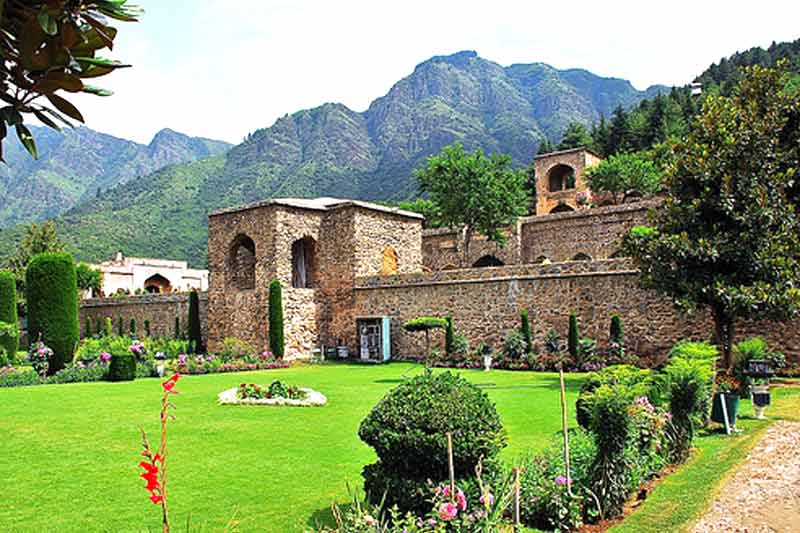
The name Pari Mahal appears to be a distorted version of "Peer Mahal" built by Prince Dara Shikoh, eldest son of Emperor Shah ]ahan in the year 1640 A.D. for his tutor Peer Mullah Shah. Once the royal observatory, it is a seven terraced garden located on the base of Zabarvan mountain range over-looking city of Srinagar and Dal-Lake. The Mahal Built for the meditation and summer residence of Peer Mullah Shah is a replica of typical Mughal architecture in garden layout, water now been restored to its glory with captivating terraced gardens, motorable road up to the garden and wonderful lighring effects which look marvelous and captivating at night. It covers an area of about 3.20 ha.
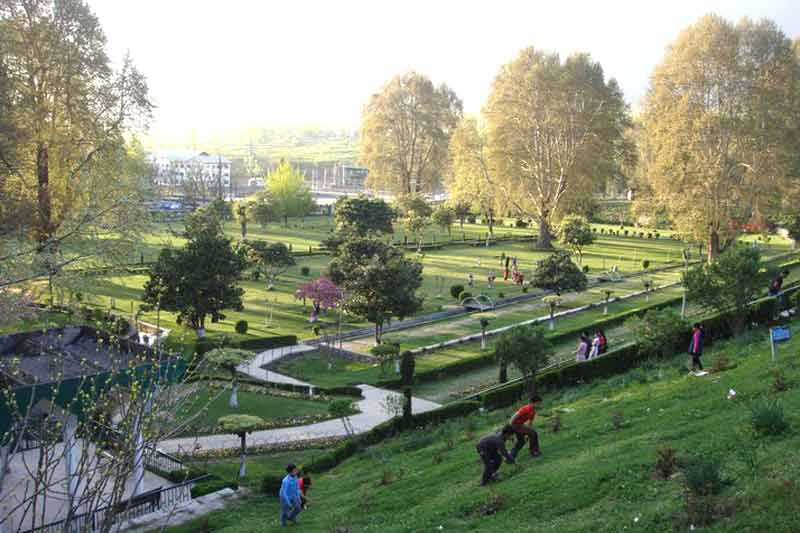
On the hillside, south of the village of Harwan (19 kms from the TRC)), remarkable remains of ancient ornamented tile pavements of the Buddhist period have come to light. The tiles depict the dresses of the people, such as loose trousers, Turkoman caps or close fitting turbans and large ear-rings which reveal Central Asian influence. It is ASI site.
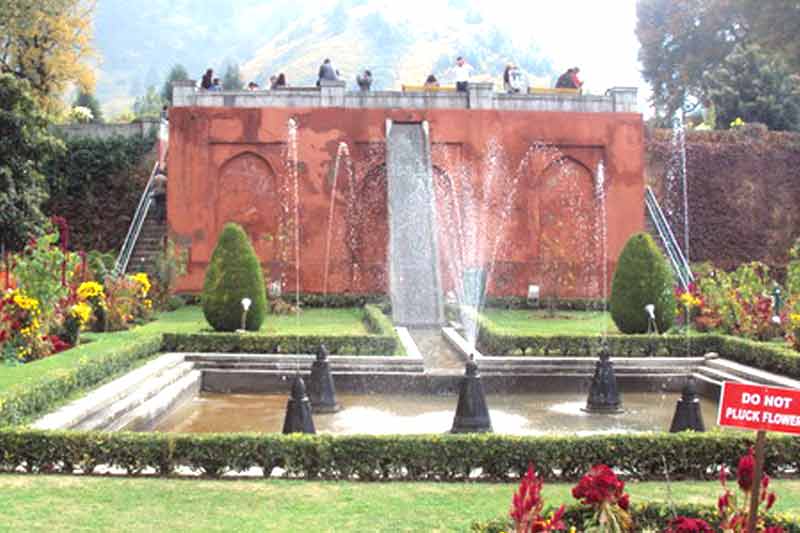
This beautiful landscape garden took birth in the year 1969 on the enchanting Zabarwan mountain slopes near famous Mughal Garden Cheshmashahi, over¬looking the panorama of Dal-Lake. This pleasure garden complex extends over an area of about 80 hectares and consists of several styles of gardens with unending joy for seekers of solace on informal and undulated landscape. It comprises of four components- Recreational Garden, Botanical Garden, Research Section, and Plant Introduction Centre. A beautiful lake spread over an area of 17 hectares with joy riding boats is also the attraction of the garden. The garden provides a 3.5 Kilometer joyride, a pleasant water garden, inspiring colour feast of spring, fragrance and colour pageantry of roses, riot of colours in summer, changing autumn colours and captivating twitter of water falls. Over 1.5 Lakh ornamental plants, representing about 300 plant species have been planted in the garden.
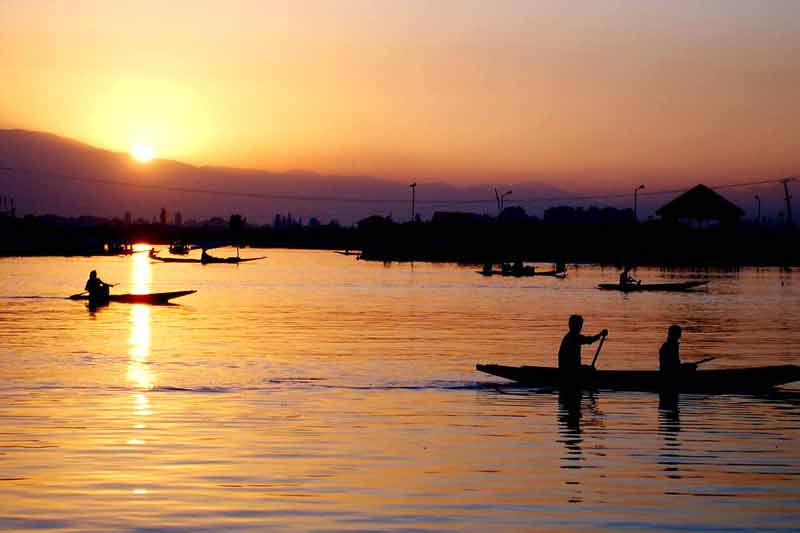
Dal Lake is one of the most beautiful lakes of India and the second largest in the J&K state. Its three sides are surrounded by majestic mountains and a large number of gardens and orchards have been laid along the shores. The campus of University of Kashmir is also located along the shores of the lake. Dal Lake is unique in having hundreds of houseboats, which afford an opportunity for tourists to reside on the lake in an atmosphere of peace and tranquility .
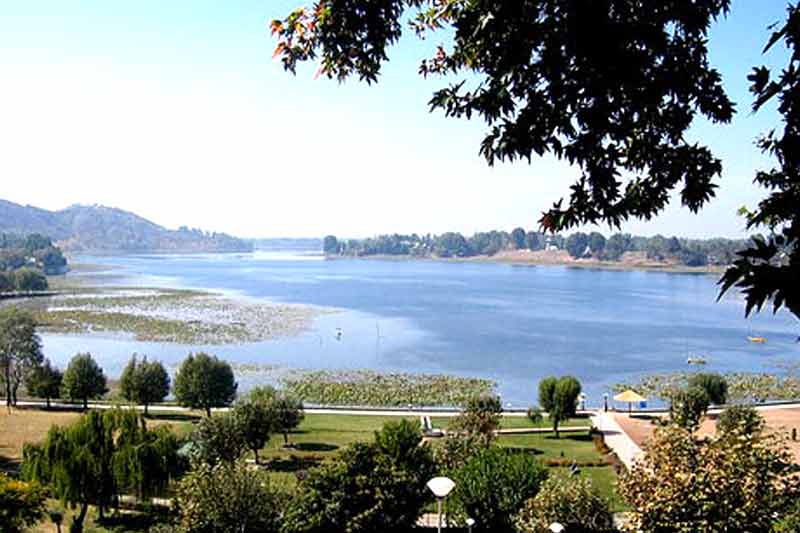
It is located about 30 km north of Srinagar. Manasbal Lake is considered as the supreme gem of all Kashmir lakes with lotus (Nelumbonucifera) nowhere more abundant or beautiful than on the margins of this lake during July and August. Manasbal Lake is the deepest lake of Kashmir valley and perhaps the only one that develops stable summer satisfaction.
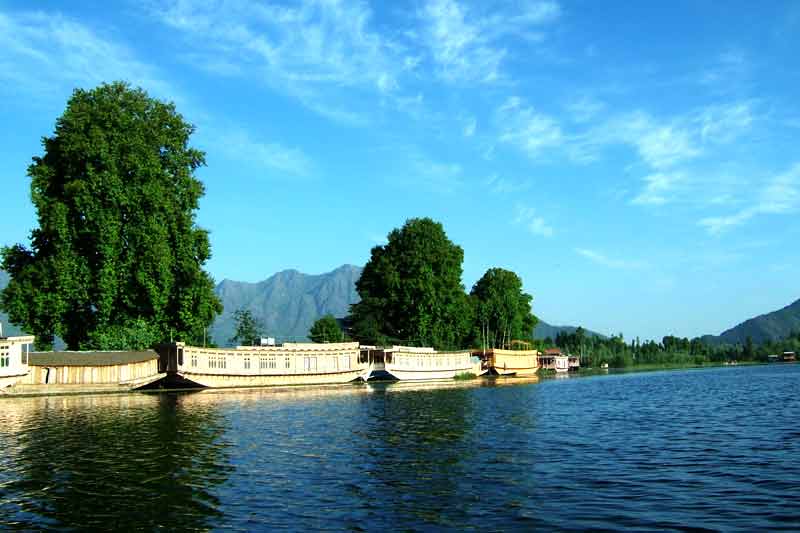
Nagin lake is located just a small distance away from Dal Lake. In fact both the water bodies are interconnected by a small water channel. In summer time the water is pleasantly cool. The lake is one of the best ions, which you can enjoy a captivating round of boating. Even in the middle of the lake you can experience the thrill of shopping. There are boats that are full-fledged shops on the move. You can buy eateries exquisite handicrafts,even the famous Pashmina shawls, and if you wish, you can even make a call from the mobile phone booths
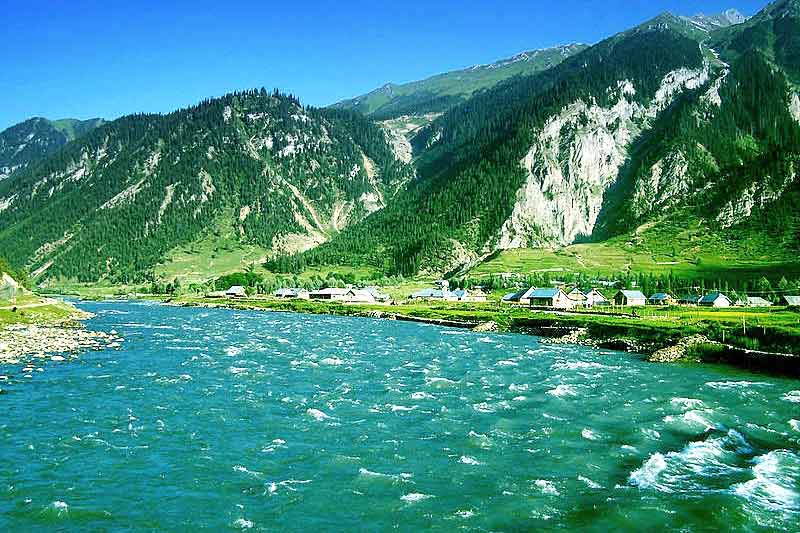
Gurez is a valley located in the high Himalayas, about 123 kilometres from Srinagar in northern Jammu and Kashmir. At about 8,000 feet(2,400 m) above sea level, the valley is surrounded by snow capped mountains. It has diverse fauna and wildlife including the Himalayan brown bear and the snow leopard. The Kishan Ganga river flows through the valley. The road to gilgit runs through Gurez. Tourist acomodation is also available at Gurez
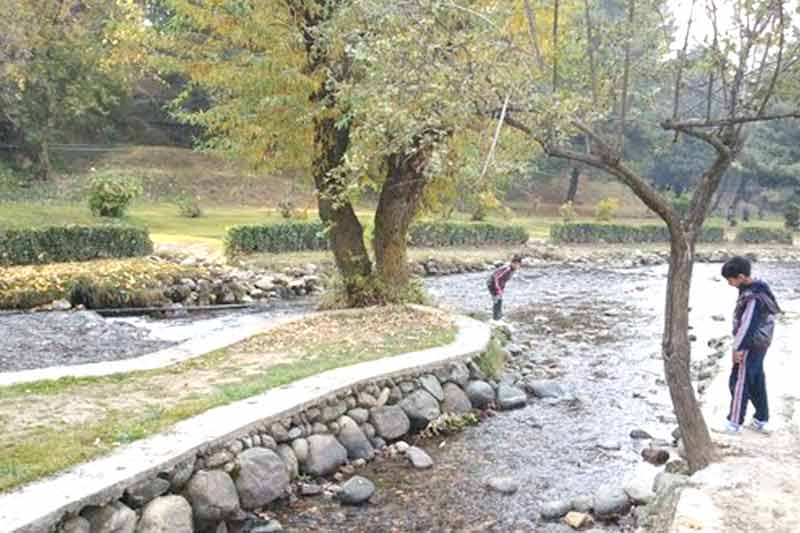
Situated the lower of Bringhi valley, Kokernag (2,020 m, 70 kms from Srinagar), is set amidst sprawling gardens fragrant with the bloom of thousands of flowers. The Kokernag spring bubbles at seven places at the foot of the forested mountain. The water of the spring is famous for its medicinal and digestive properties.
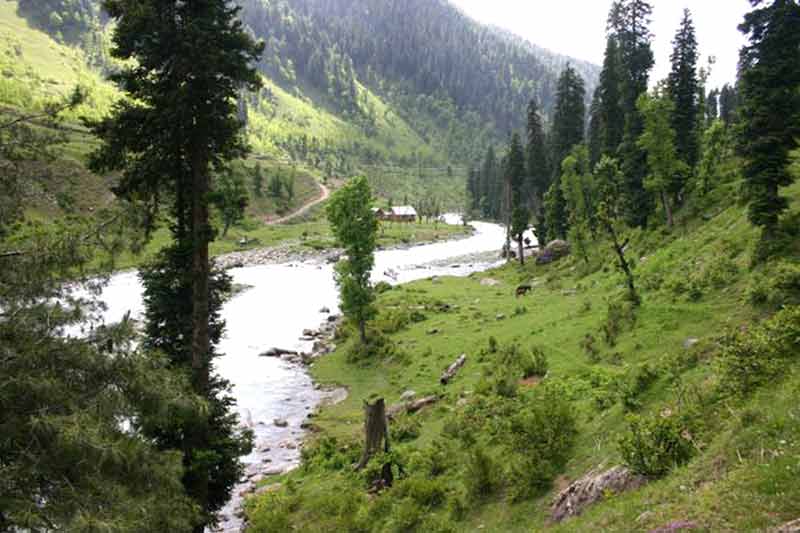
Past Mughals gardens of Achabal with their tinkling fountains , thorugh the breathtaking splendour of the springs at Kokernag, lies Daksum. Quite away from it all , tucked away in a densely forested gorge, Daksum would be completely silent but for the Bringhi river which gushes though it. Daksum is a walker's paradise. Up the hills which are swathed in coniferous trees, past gurgling brooks, the simple, haunting notes of a flute will waft down to you from where an unseen shepherd tends his flock. For in the hills surrounding Daksum, suddenly you will find yourself in grassy meadows where sheep are taken to pasture. Daksum is a reviving experience - the bracing mountain air, the soltitude , the densely clad hills, and beyond them , snow covered mountains all contribute to Daksum's mystique , making it the perfect retreat
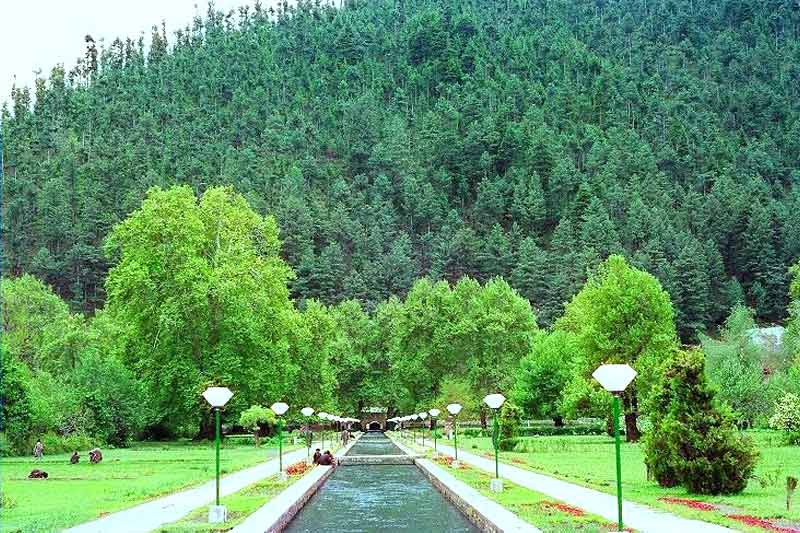
Located 80 kms from Srinagar at an altitude of 1,876 m, the spring of Verinag is believed to be the chief source of the river Jhelum. Construction of the octagonal base of the spring and the arcade around it was undertaken by the Mughal Emperor Jahangir and completed during the reign of Shah Jahan. Down the stream to the east lie the remains of a Mughal pavilion and baths. Verinag can be approached through the link road, which turns off, from the national highway at Lower Munda.
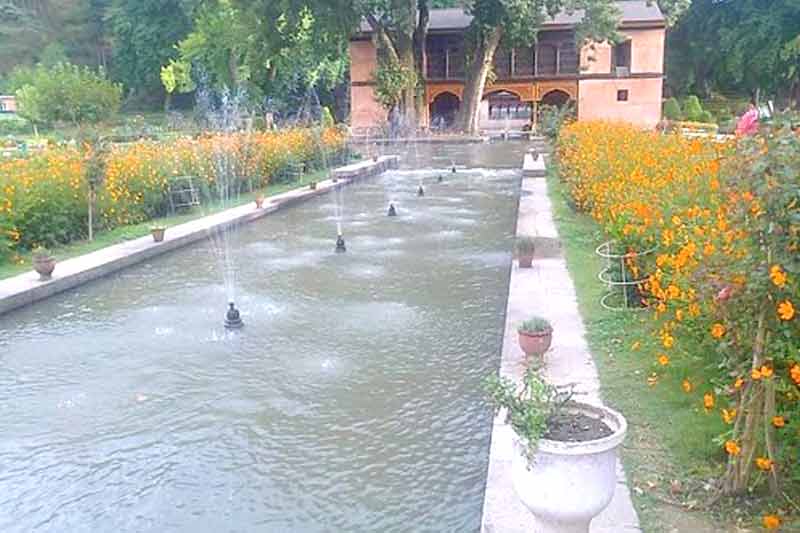
Once the pleasure retreat of Empress Nur Jehan, Achabal(1,677 m) has a fine garden in the Mughal style, with its own special charm nad character Situated at the foot of a hill with a row of majestic chinars framing it, the Mughal garden is a visual delight with their stepped terraces, formal elegance, ornaments shrubs, sparkling fountains and falling water. Achabal is 58 kms from Srinagar, via Anantnag.
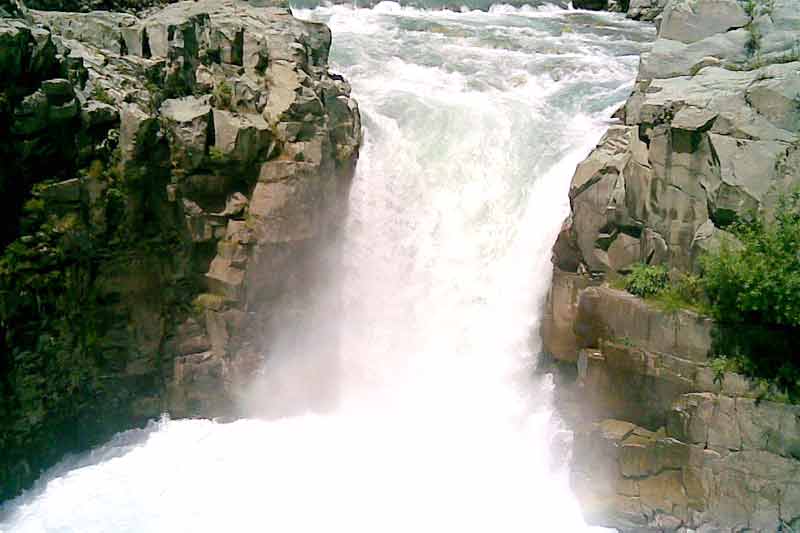
Gradually, the distant rumble becomes a roar as one approach the waterfall of Aharbal, which crashes down a narrow gorge. Aharbal is more than just a waterfall. There are several places to picnic in the surrounding areas, as well as delightful walks of varying lengths all over the hillsides. Interesting treks-one of them to the high altitude lake of Kounsernag at 13,500 ft above sea level-takes off from Aharbal. waterfall.
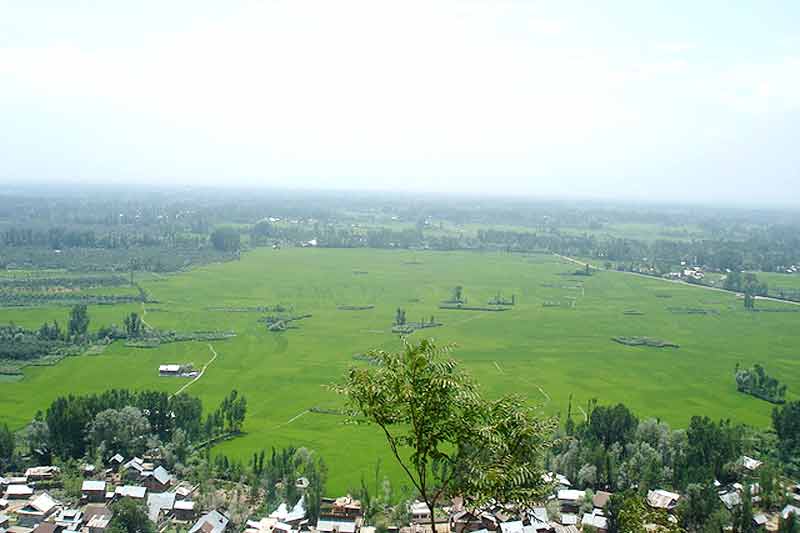
Gradually , the panoply of the 'real Kashmir' miles away from well-traversed areas , will unfold before you, and you will reach Watlab. Here , high on a hilltop is the shrine of a Muslim mystic, Baba Shukurdin. From here, the Wular stretches away as far as the eye can see , edged by picturesque villages, and terraced breeze-rippled fields of paddy in a riotous burst of colour. At Watlab is a Forest Rest House amidst sprwaling apple orchards. Permission has to be sought from the Forest Department Office at Sopore district headquarters.
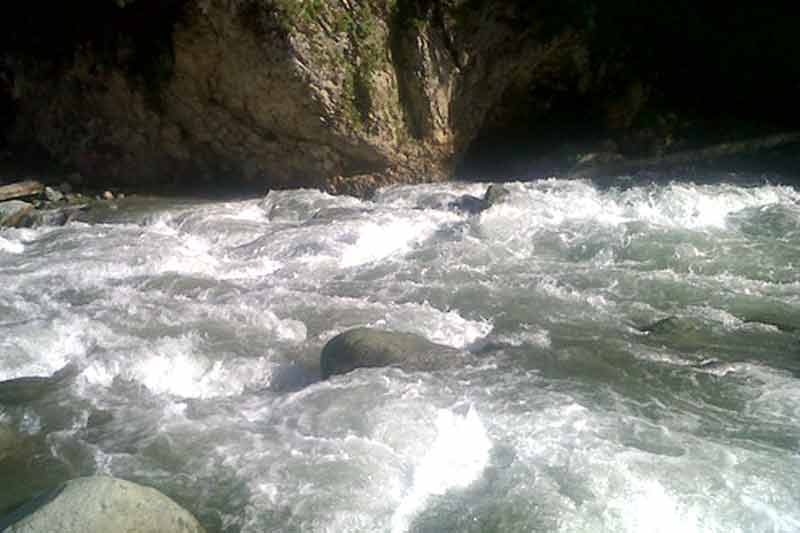
Doodh-e-pathri is yet another bowl shaped valley about 42 kms from Srinagar. It is a recent discovery in the valley covered with green carpeted meadows. It is said that the cattle grazing in the meadows of Doode-e-Pather, produces rich milk in large quantity and because of this reaso it is called the "place of milk" Doodh-e-Pather.
Srinagar - Gulmarg - Pahalgam - Srinagar
Jammu - Srinagar - Sonmarg - Gulmarg - Pahalgam - Srinagar
Jammu - Pahalgam - Gulmarg - Srinagar - Jammu
Srinagar – Sonomarg - Gulmarg - Pahalgam - Manasbal Lake
Srinagar - Gulmarg - Pahalgam - Srinagar - Sonamarg
Srinagar - Gulmarg - Pahalgam - Srinagar – Sonamarg - Srinagar
Srinagar - Sonamarg - Gulmarg - Pahalgam - Srinagar - Yusmarg
Srinagar - Sonamarg - Gulmarg - Pahalgam - Srinagar - Yusmarg
Srinagar - Gulmarg - Pahalgam - Srinagar - Sonamarg - Srinagar -Yusmarg - Patnitop – Katra - Jammu
Srinagar - Gulmarg - Sonamarg - Pahalgam - Katra - Vaishno Devi - Dharamshala - Manali - Shimla - Amritsar - Chandigarh - Delhi - Agra

